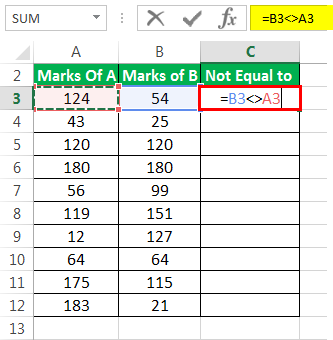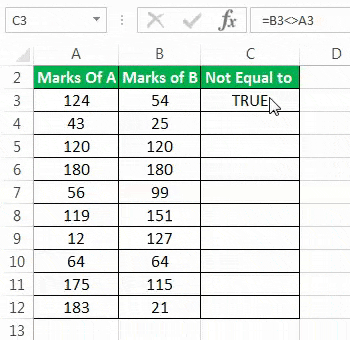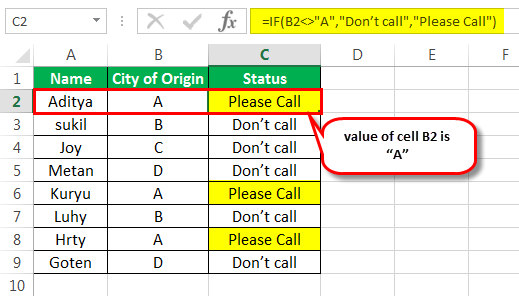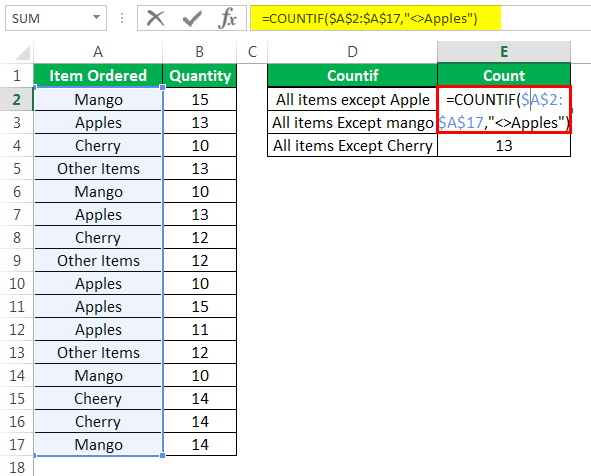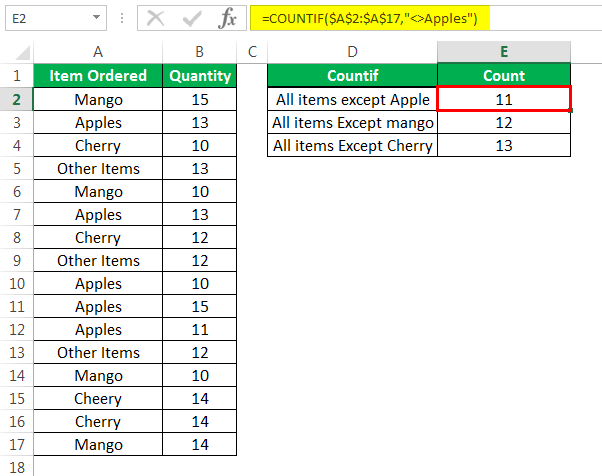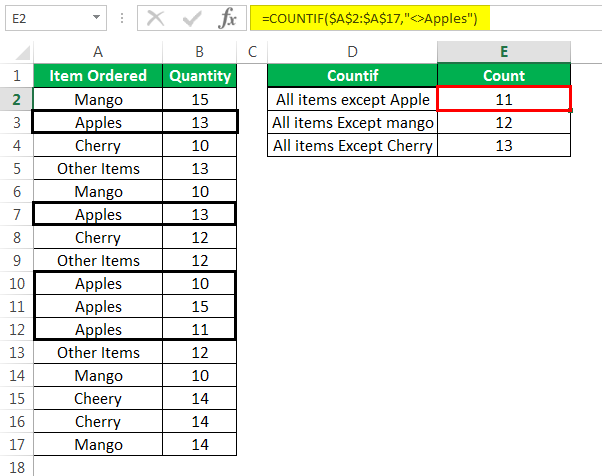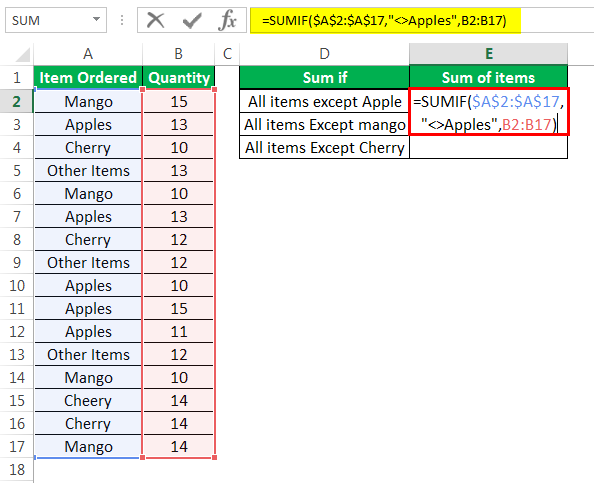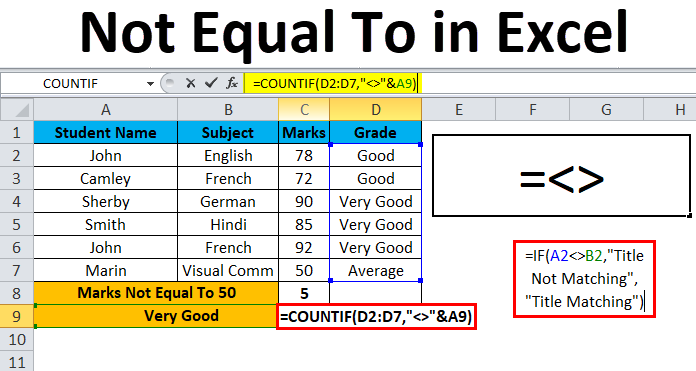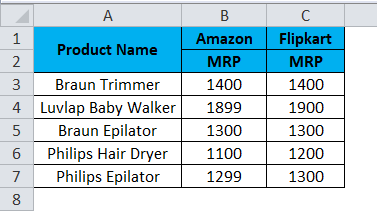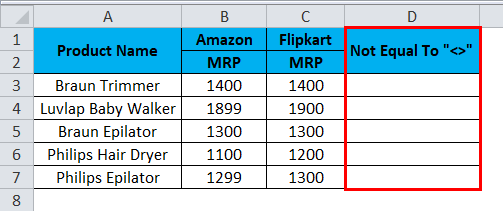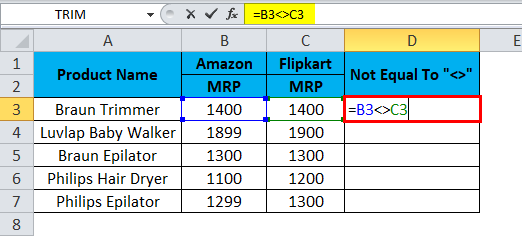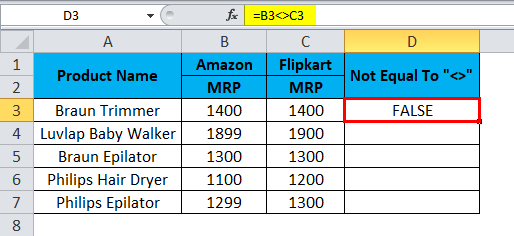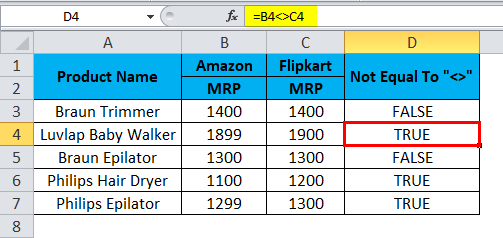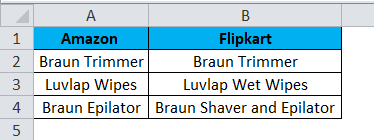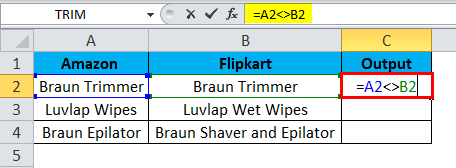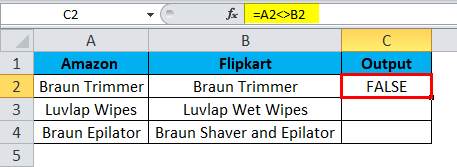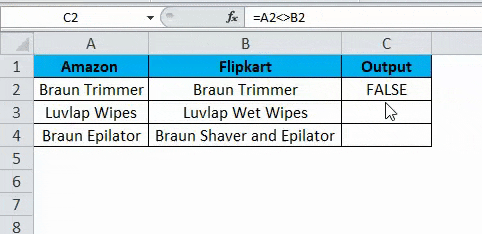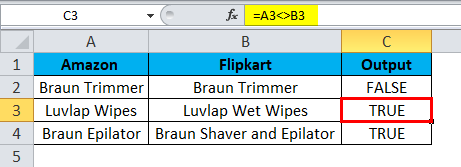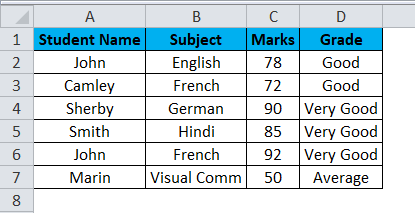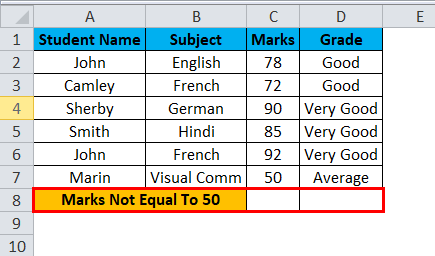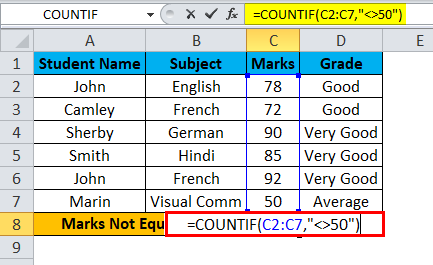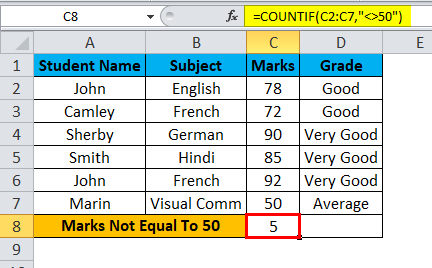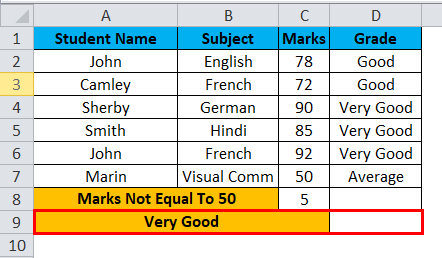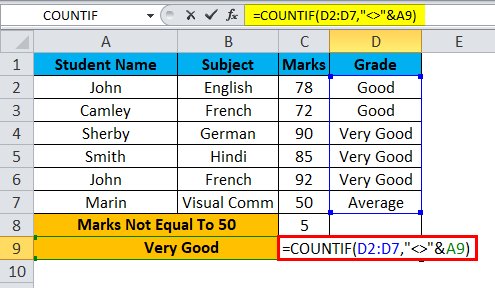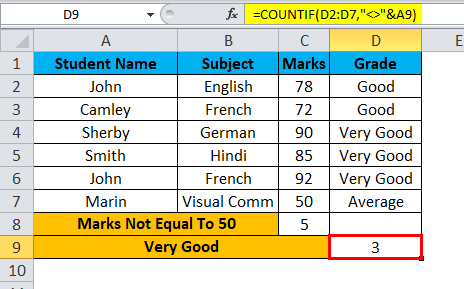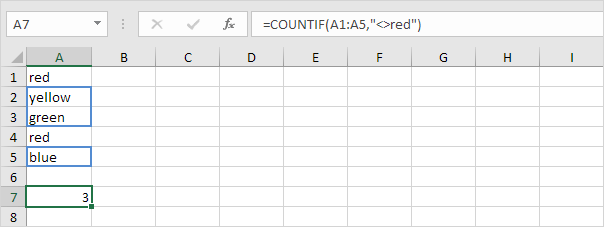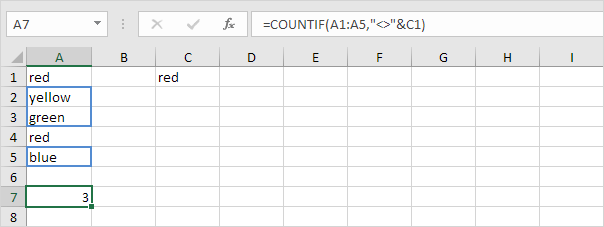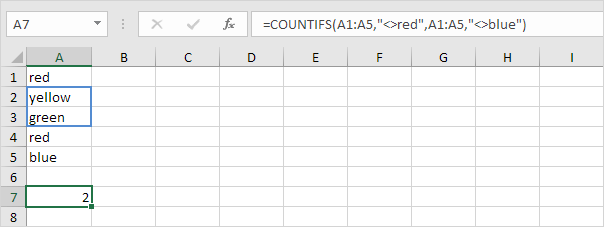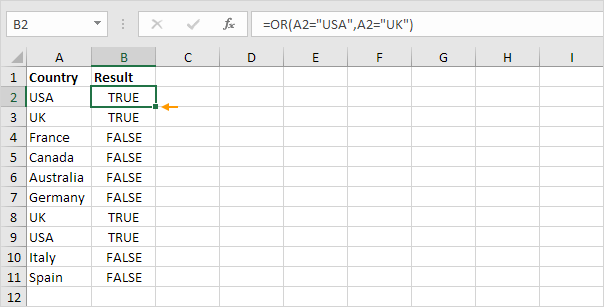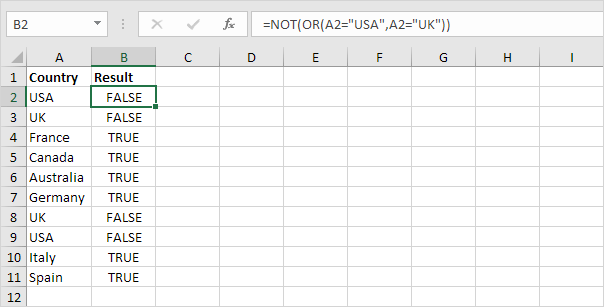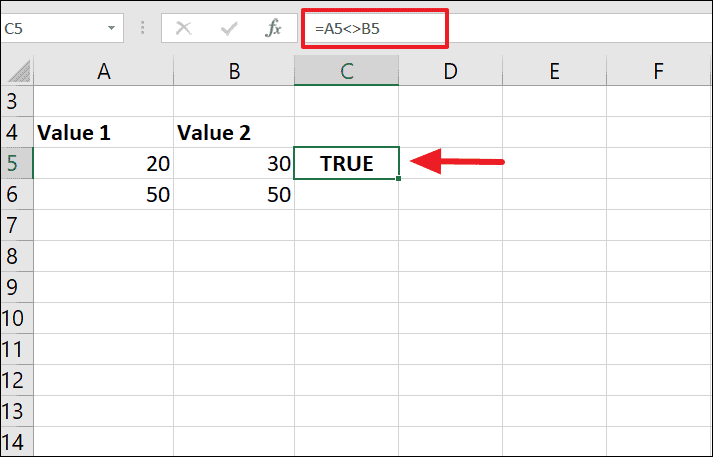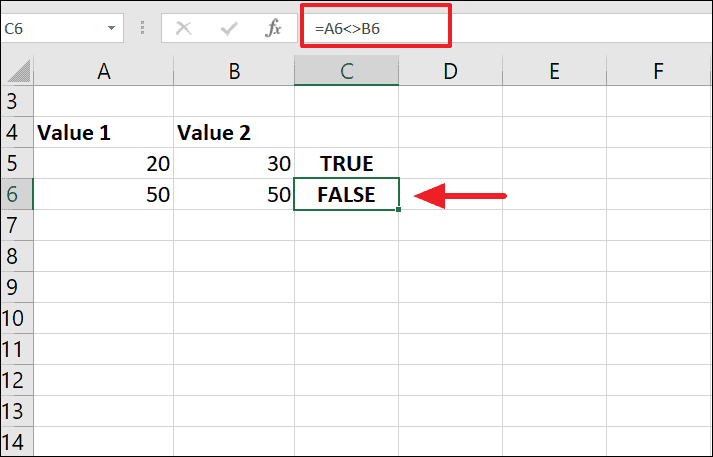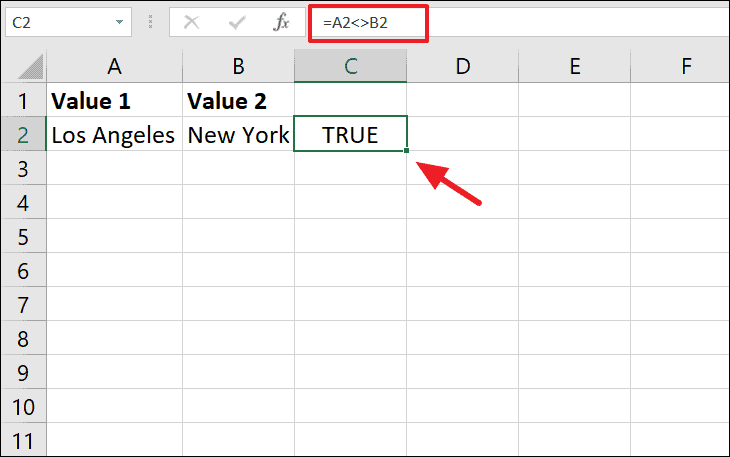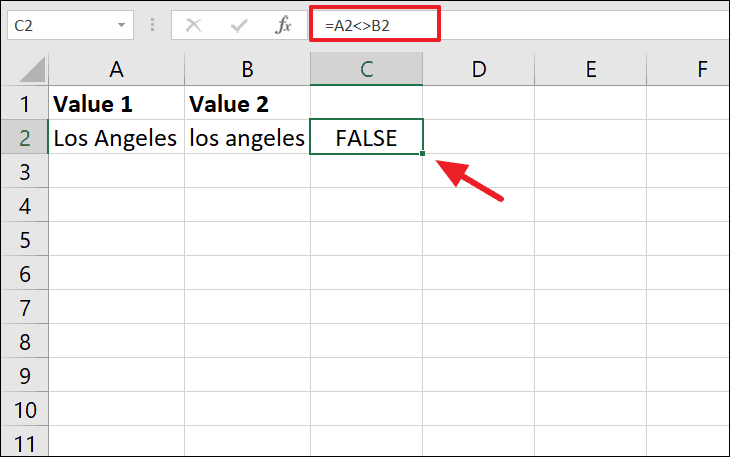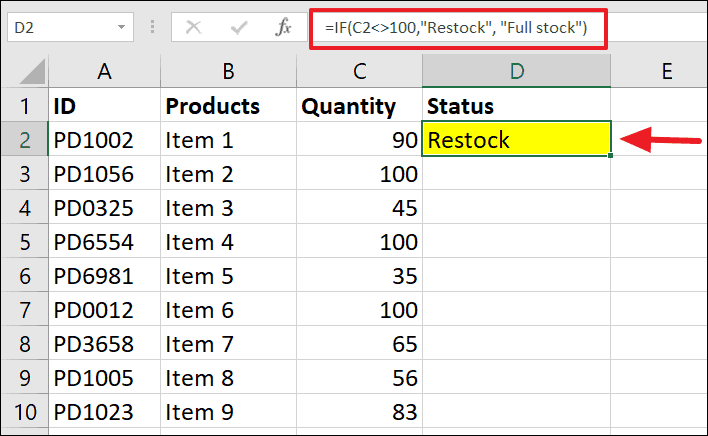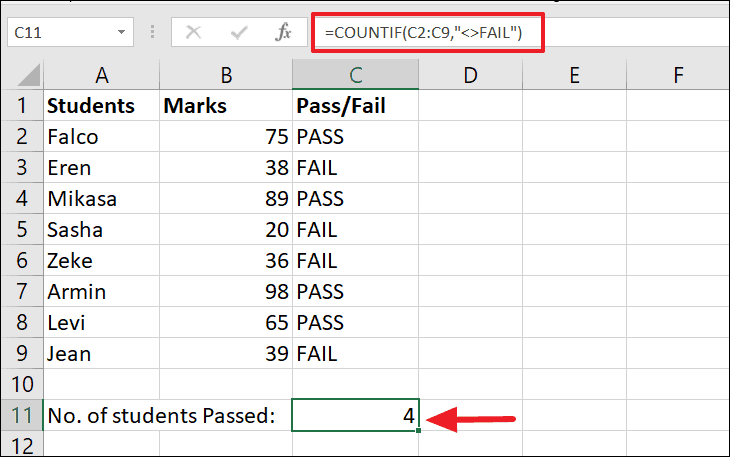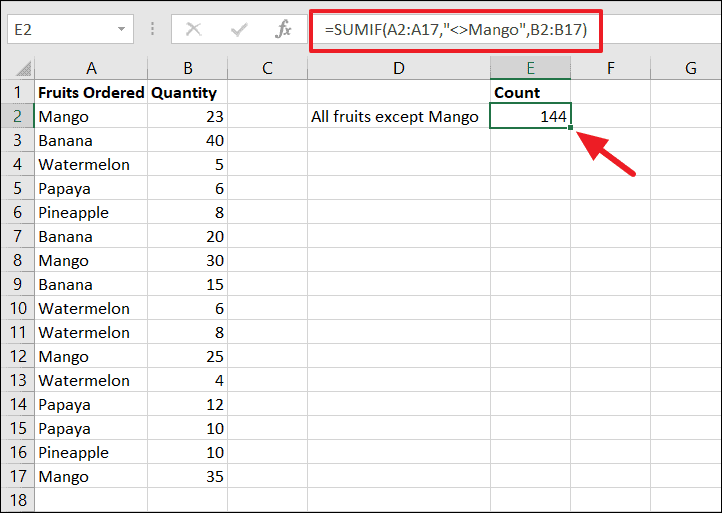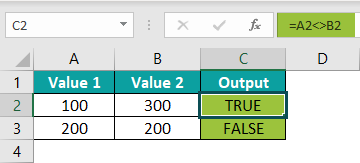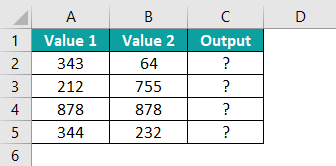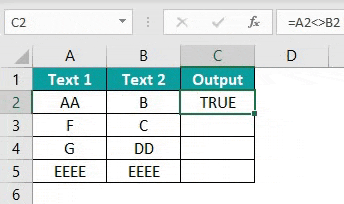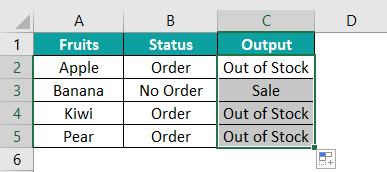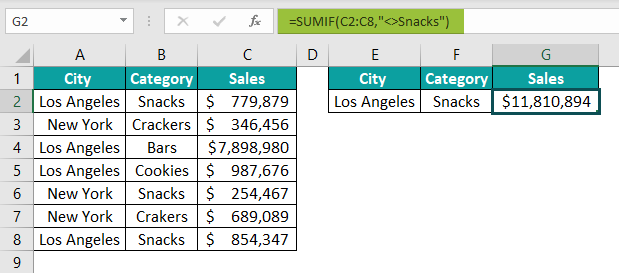What is “Not Equal To” Sign in Excel?
The “not equal to” is a logical operator in excel that helps compare two numerical or textual values. It is written (like <>) using a pair of angle brackets pointing away from each other. The “not equal to” excel sign returns either of the two Boolean values (true and false) as the outcome
- True implies that the two compared values are different or not equal.
- False implies that the two compared values are the same or equal.
For example, “=2<>4” (ignore the double quotation marks) returns “true” since the numbers 2 and 4 are not equal to each other.
The “not equal to” is used in the arguments of several Excel functions. The purpose of using the “not equal to” is to assess whether two values are different or not. However, the magnitude of difference is not conveyed by this operator.
Table of contents
- What is “Not Equal To” Sign in Excel?
- How is the “Not Equal To” Sign Used in Excel?
- Example #1–Compare two Numeric Values with the “Not Equal To” Operator
- Example #2–Compare two Textual Values with the “Not Equal To” Operator
- Example #3–Obtain Defined Results with the IF Function and the “Not Equal To” Condition
- Example #4–Count Specific Cells with the COUNTIF Function and the “Not Equal To” Condition
- Example #5–Sum Particular Cells with the SUMIF Function and the “Not Equal To” Condition
- The Key Points Related to the “Not Equal To” Operator of Excel
- Frequently Asked Questions
- Recommended Articles
- How is the “Not Equal To” Sign Used in Excel?
How is the “Not Equal To” Sign Used in Excel?
Let us consider some examples to understand the working of the “not equal to” operator in Excel.
You can download this Not Equal to Excel Template here – Not Equal to Excel Template
Example #1–Compare two Numeric Values with the “Not Equal To” Operator
The succeeding image shows the marks of students A and B (columns A and B) in 10 subjects. The total marks of each subject are 200. We want to find those rows for which the marks of the two students are unequal. Use the “not equal to” signof Excel.
The steps to find if a difference exists between the two marks are listed as follows:
Step 1: In cell C3, type the “equal to” symbol followed by the cell reference B3. Since the difference between cells B3 and A3 needs to be assessed, insert the “not equal to” sign between these two cell references.
The formula should look like the expression “=B3<>A3.” This expression is also known as a statement or a condition.
Note: A condition in Excel is an expression that evaluates to either true or false. At a given time, a condition cannot be assessed as both true and false.
Step 2: Press the “Enter” key. The output in cell C3 is “true.” This is shown in the following image.
Step 3: Drag the formula of cell C3 till cell C12 by using the fill handle. This is shown in the following image.
Step 4: The outputs for the entire column C are shown in the following image. The outputs which are false have been colored yellow. The inferences from this dataset are stated as follows:
- If the output is “true,” the values of column A and column B for a given row are not equal. This means that the “not equal to” excel condition for that particular row is met. For instance, the “not equal to” condition for row 3 is “=B3<>A3.” In other words, 124 is not equal to 54.
- If the output is “false,” the values of column A and column B for a given row are equal. This means that the “not equal to” condition for that particular row is not met. For instance, the “not equal to” condition for row 5 is “=B5<>A5.” In other words, 120 is certainly equal to 120.
Overall, for three rows (rows 5, 6, and 10), the marks of students A and B are equal. Except for these rows, the marks are unequal in all the remaining rows (rows 3, 4, 7, 8, 9, 11, and 12). Without knowing the magnitude of difference, one cannot conclude whose performance (from students A and B) is better.
Example #2–Compare two Textual Values with the “Not Equal To” Operator
In the dataset of example #1, we have substituted random grades (from A to J) in place of numbers. We want to find the rows for which the grades of students A and B are unequal. Use the “not equal to” operator of Excel.
The steps to find if a difference exists (between the grades) are listed as follows:
Step 1: Enter the formula “=B3<>A3” in cell C3. Press the “Enter” key. The output in cell C3 is “true.” So, for row 3, the “not equal to” excel operator has validated that the values in the first and second cell (A3 and B3) are not equal.
Step 2: Drag the formula of cell C3 till cell C12. The outputs for the entire column C are shown in the following image. The single false output has been colored yellow.
The output in cell C3 meets the “not equal to” excel condition, which is “=B3<>A3.” In contrast, the output in cell C11 does not meet the “not equal to” condition, which is “=B11<>A11.” Hence, the grades of all rows, except row 11, are unequal. The grades of the two students are equal for row 11.
Example #3–Obtain Defined Results with the IF Function and the “Not Equal To” Condition
The succeeding image shows the names of a few candidates and their native places in columns A and B respectively. From these candidates, an organization wants to hire those candidates whose city of origin is “A.”
We want to differentiate candidates who need to be contacted and who need not be contacted for the further hiring process. For this, display the status as either “please call” or “don’t call” (in column C), depending on whether the hometown of a candidate is “A” or not.
Use the IF function and the “not equal to” operator of Excel.
The steps to use the IF functionIF function in Excel evaluates whether a given condition is met and returns a value depending on whether the result is “true” or “false”. It is a conditional function of Excel, which returns the result based on the fulfillment or non-fulfillment of the given criteria.
read more and the “not equal to” operator are listed as follows:
Step 1: Enter the following formula in cell C2.
“=IF(B2<>”A”,”Don’t call”,”Please Call”)”
Press the “Enter” key. Drag the formula till cell C9. The outputs of column C are shown in the succeeding image. The candidates whose city of origin is “A” have been assigned the “please call” status in column C.
Note: In the given IF formula, the condition [B2<>“A”] is the logical test. The string “don’t call” is “value_if_true” and the string “please call” is “value_if_false.”
So, the IF formula returns “don’t” call” for a given row, if the value of column B is not equal to “A” (i.e., the condition is true). It returns “please call” for a given row, if the value of column B is equal to “A” (i.e., the condition is false).
With the help of the IF function, Excel can display different results for the matched and unmatched conditions. For more details related to the IF function of Excel, click the hyperlink given immediately before step 1 of this example.
Step 2: The candidates whose hometown is other than “A” have been assigned the “don’t call” status in column C. This is shown in the following image.
Hence, only candidates “Aditya,” “Kuryu,” and “Hrty” should be called for the further round of interviews. The remaining candidates need not be contacted.
So, with the IF function and the “not equal to” excel operator, we have successfully differentiated the candidates who can be hired from those who cannot be hired.
Note: Notice that this step has been added only for the purpose of understanding. The preceding step (step 1) is complete in itself for the given task of hiring candidates.
Example #4–Count Specific Cells with the COUNTIF Function and the “Not Equal To” Condition
The succeeding image shows certain fruits (or items) in column A and their quantities ordered in column B. Apart from apples, mangoes, and cherries, the remaining fruits have been clubbed under “other items” in column A.
We want to count the number of cells (of column A) that are not equal to:
- “Apples”
- “Mango”
- “Cherry”
There should be three outputs, one output excluding one fruit. Use the COUNTIF function and the “not equal to” operator of Excel.
The steps to use the COUNTIF functionThe COUNTIF function in Excel counts the number of cells within a range based on pre-defined criteria. It is used to count cells that include dates, numbers, or text. For example, COUNTIF(A1:A10,”Trump”) will count the number of cells within the range A1:A10 that contain the text “Trump”
read more and the “not equal to” operator are listed as follows:
Step 1: Enter the following formulas in cells E2, E3, and E4 respectively.
- “=COUNTIF($A$2:$A$17,”<>Apples”)”
- “=COUNTIF($A$2:$A$17,”<>Mango”)”
- “=COUNTIF($A$2:$A$17,”<>Cherry”)”
Press the “Enter” key after entering each formula.
The first formula counts the number of cells in the range A2:A17, which do not contain the string “apples.” Likewise, the second formula counts the number of cells in this range that do not contain the string “mango.” The third formula helps count the number of cells in the given range (A2:A7), which do not contain the string “cherry.”
Notice that the succeeding image shows the formula in cell E2 and the result of the third formula in cell E4.
Note: “$A$2:$A$17” is the “range” argument of the preceding COUNTIF formulas. The condition “<>Apples” is the “criteria” argument of the first formula. In all the preceding formulas, the range is the same, but the criterions are different.
The COUNTIF counts the cells of a range, which satisfy a single criterion. For more details related to the COUNTIF function, click the hyperlink given before step 1 of this example.
Step 2: The following image shows the three outputs (in cells E2, E3, and E4) of the three formulas entered in the preceding step.
Notice that “cherry” has been deliberately misspelled as “cheery” in cell A15. As a result, this cell has also been counted (as a cell not containing “cherry”) by the third COUNTIF formula.
Had the word been correctly spelled in cell A15, the output in cell E4 would have been 12. In this case, cell A15 would have been excluded from the count (as a cell containing “cherry”).
Step 3: The rows containing “apples” are displayed in black boxes in the following image. These rows are excluded while counting the cells not containing “apples.” Hence, 11 cells (in the range A2:A17) do not contain the string “apples.”
Likewise, in the given range, 12 cells do not contain the string “mango” and 13 cells do not contain the string “cherry.”
Note: This step has been added only for notifying the readers, the cells that are counted and the cells that are left out by the first COUNTIF formula (entered in step 1).
Example #5–Sum Particular Cells with the SUMIF Function and the “Not Equal To” Condition
Working on the data of example #3, we want to sum the quantities of column B that are not equal to:
- “Apples”
- “Mango”
- “Cherry”
There should be three summed outputs where each output excludes one fruit. Use the SUMIF function and the “not equal to” sign of Excel.
The steps to use the SUMIF functionThe SUMIF Excel function calculates the sum of a range of cells based on given criteria. The criteria can include dates, numbers, and text. For example, the formula “=SUMIF(B1:B5, “<=12”)” adds the values in the cell range B1:B5, which are less than or equal to 12.
read more and the “not equal to” operator are listed as follows:
Step 1: Enter the following formulas in cells E2, E3, and E4 respectively.
- “=SUMIF($A$2:$A$17,”<>Apples”,B2:B17)”
- “=SUMIF($A$2:$A$17,”<>Mango”,B2:B17)”
- “=SUMIF($A$2:$A$17,”<>Cherry”,B2:B17)”
The first formula is shown in the following image.
In all three formulas, the SUMIF function evaluates the range A2:A17. For cells not equal to “apples” (in range A2:A17), the first formula sums the numbers of the range B2:B17. Likewise, for cells not equal to “mango” in the given range (A2:A17), the second formula also sums the numbers of the range B2:B17. Similar summing is carried out by excluding cells containing “cherry.”
Note: “$A$2:$A$17” is the “range” argument of the SUMIF function. The condition “<>Apples” is the “criteria” argument. The range “B2:B17” is the “sum_range” argument of the SUMIF function.
With the SUMIF function, we have applied the given condition (in each formula) to the range A2:A17 and summed up the corresponding values of the range B2:B17. Usually, the SUMIF works with a single criterion. For more details related to the SUMIF function, click the hyperlink given before step 1 of this example.
Step 2: Press the “Enter” key after entering each of the preceding formulas. The three summed outputs are shown in the following image.
Hence, the sum of all the fruit quantities except “apples” is 136. Excluding the cells containing “mango,” this sum is 149. Likewise, leaving the cells containing “cherry,” this sum is 162.
Notice that the value of cell B15 has also been included in the sum returned (in cell E4) by the third SUMIF formula (entered in step 1). This is because in cell A15, the spelling of “cherry” has been misspelled as “cheery.” Hence, Excel considers A15 as a cell not containing “cherry.”
The important points governing the usage of the “not equal to” operator of Excel are listed as follows:
- The “not equal to” is the converse of the “equal to” operator. This implies that the interpretation of “true” and “false” is exactly the opposite with these two logical operators.
- The results produced by the “not equal to” operator are similar to those returned by the NOT function of Excel. The NOT function reverses the “true” and “false” outcomes of a condition. For instance, if the output of a condition is “false,” the formula “=NOT(false)” returns “true.”
- The “not equal to” operator is case-insensitive. This means that it ignores the casing of the two text strings that are compared. For instance, if “rose” and “ROSE” are compared using the “not equal to” operator, the output is “false.” This is because these two values mean the same to the “not equal to” excel operator.
Frequently Asked Questions
1. Define the “not equal to” operator and state how is it used in Excel.
The “not equal to” excel operator checks whether two values (numeric or textual) being compared are different from each other or not. If the values are different, the output is “true.” If the values are the same, the output is “false.” The “not equal to” operator is the easiest method to ensure that a difference exists between two values.
In Excel, the “not equal to” operator is used as follows:
“=value1<>value2”
“Value1” is the first value to be compared and “value2” is the second value to be compared.
Note: Exclude the beginning and ending double quotation marks while entering the “not equal to” condition in Excel. For more details related to the usage of this operator, refer to the examples of this article.
2. How to use the “not equal to” operator with the conditional formatting feature of Excel?
The steps to use the “not equal to” with the conditional formatting feature of Excel are listed as follows:
a. Select the range on which a conditional formatting rule is to be applied.
b. From the Home tab, click the “conditional formatting” drop-down from the “styles” group. Next, click “new rule.”
c. The “new formatting rule” window opens. Under “select a rule type,” choose the option “use a formula to determine which cells to format.”
d. Under “format values where this formula is true,” enter the desired formula. For instance, if cells (in the range A1:A6) not equal to 2 are to be formatted, enter the formula as “=A1<>2” (without the beginning and ending double quotation marks).
e. Click “format” and select a color from the “fill” tab. Click “Ok” in the “format cells” window.
f. Click “Ok” again in the “new formatting rule” window.
The chosen color (selected in step “e”) is applied to the selected range (selected in step “a”). If the formula given in step “d” is applied, the cells of the range A1:A6, which do not contain 2, are colored. No formatting is applied to the remaining cells.
Note: To conditionally format a range of text values by using the “not equal to” operator, keep the string of the formula in double quotation marks. For instance, the formula [=A1<>“rose”] formats those cells of the selected range which do not contain the string “rose.” Exclude the beginning and ending square brackets while applying this formula.
3. How to use the “not equal to” operator to find blanks in a range of Excel?
The steps to find blanks in Excel by using the “not equal to” operator are listed as follows:
a. Enter the formula containing the cell reference (to be evaluated), “not equal to” operator, and an empty text string. For instance, if blanks in the range A1:A6 are to be found, enter the formula =A1<>“” in cell B1.
b. Press the “Enter” key. Drag the formula to the remaining range (of column B) to obtain outputs for the entire column (column A).
The cells containing blanks have been identified. The formula entered in step “a” returns “true” for all values which are not blanks. For all blank values, this formula returns “false.”
Since the double quotation marks of the formula represent an empty string, a “false” implies that the cell value is equal to an empty string. Conversely, a “true” implies that the cell contains some value, which is not equal to an empty string.
Recommended Articles
This has been a guide to the “not equal to” operator/sign of Excel. Here we discuss how to use the “not equal to” formula in Excel along with step-by-step examples and a downloadable Excel template. You may learn more about Excel from the following articles–
- VBA IF NOT In VBA, IF NOT is a comparison function that compiles statements and provides inverted outcomes. The function returns “FALSE” if the logical test is correct, and “TRUE” if the logical test is incorrect.read more
- NOT Excel FunctionNOT Excel function is a logical function in Excel that is also known as a negation function and it negates the value returned by a function or the value returned by another logical function.read more
- VBA OR FunctionOr is a logical function in programming languages, and we have an OR function in VBA. The result given by this function is either true or false. It is used for two or many conditions together and provides true result when either of the conditions is returned true.read more
- How to use OR in Excel?
Excel Not Equal To (Table of Contents)
- Not Equal To in Excel
- How to Put ‘ Not Equal To ‘ in Excel?
Not Equal To in Excel
Not Equal To generally is represented by striking equal sign when the values are not equal to each other. But in Excel, it is represented by greater than and less than operator sign “<>” between the values which we want to compare. If the values are equal, then it used the operator will return as TRUE, else we will get FALSE. We can use the Not Equal operator along with other conditional functions as IF, SUMIF, COUNTIF function to get some other kind of meaning of results.
How to Put ‘ Not Equal To ‘ in Excel?
Not Equal To in Excel is very simple and easy to use. Let’s understand the working of Not Equal To Operator in Excel by some examples.
You can download this Not Equal To Excel Template here – Not Equal To Excel Template
Example #1 – Using ‘ Not Equal To Excel ‘ Operator
In this example, we are going to see how to use the Not Equal To logical operation <> in excel.
Consider the below example, which has values in both the columns now; we are going to check the Brand MRP of Amazon and Flipkart.
Now we are going to check that Amazon MRP is not equal to Flipkart MRP by following the below steps.
- Create a new column.
- Apply the formula in excel as shown below.
- So as we can see in the above screenshot, we applied the formula as =B3<>C3 here, we can see that in the B3 column Amazon MRP is 1400, and Flipkart MRP is 1400, so the MRP matches exactly.
- Excel will check if B3 values are not equal to C3, then it returns TRUE or else it will return FALSE.
- Here in the above screenshot, we can see that Amazon MRP is equal to Flipkart MRP, so we will get the output as FALSE, which is shown in the below screenshot.
- Drag down the formula for the next cell. So the output will be as below:
- We can see that the formula =B4<>C4; in this case, Amazon MRP is not equal to Flipkart MRP. So excel will return the output as TRUE, as shown below.
Example #2 – Using String
In this excel example, we are going to see how not equal to excel operator works in strings. Consider the below example, which shows two different titles named for Amazon and Flipkart.
Here we will check that Amazon’s title name matches the Flipkart title name by following the below steps.
- First, create a new column called Output.
- Apply the formula as =A2<>B2.
- So the above formula will check for A2 title name is not equal to B2 title name if it is not equal, it will return FALSE or else it will return TRUE as we can see that both the title names are the same and it will return the output as FALSE which is shown in the below screenshot.
- Drag down the same formula for the next cell. So the output will be as below:
- As =A3<>B3, where we can see the A3 title is not equal to the B3 title, so we will get the output as TRUE which is shown as the output in the below screenshot.
Example #3 – Using IF Statement
In this excel example, we are going to see how to use the if statement in the Not Equal To operator.
Consider the below example, where we have title names of both Flipkart and Paytm, as shown below.
Now we are going to apply the Not Equal To Excel operator inside the if statement to check both the title names are equal or not equal by following the below steps.
- Create a new column as Output.
- Now apply the if condition statement as follows =IF(A2<>B2, “Title Not Matching”, “Title Matching”)
- Here in the if condition, we used not equal to Operator to check whether the title is equal to or not equal.
- Moreover, we have mentioned in the if condition in double-quotes as “Title Not Matching”, i.e., if it is not equal to it, it will return as “Title Not Matching”, or else it will return “Title Matching”, as shown in the below screenshot.
- As we can see that both the title names are different, and it will return the output as Title Not Matching which is shown in the below screenshot.
- Drag down the same formula for the next cell.
- In this example, we can see that the A3 title is equal to the B3 title; hence we will get the output as “Title Matching “, which is shown as the output in the below screenshot.
Example #4 – Using the COUNTIF Function
In this excel example, we are going to see how the COUNTIF Function works in the Not Equal To operator.
Consider the below example, which shows student’s subject marks along with the grade.
Here we are going to count how many students have taken the marks in it equal to 94 by following the below steps.
- Create a new row named as Marks Not Equal To 50.
- Now apply the COUNTIF formula as =COUNTIF(C2:C7,”<>50″)
- As we can see in the above screenshot, we have applied the COUNTIF function to find out Student marks not equal to 50. We have selected the cells C2:C7, and in the double quotes, we have used <> not equal to Operator and mentioned the number 50.
- The above formula counts the student’s marks which is not equal to 50, and return the output as 5, as shown in the below result.
- In the below screenshot, we can see that marks not equal to 50 are 5, i.e. Five students scored marks more than 50.
- Now we will use a string to check the student’s grade stating how many students are not equal to the grade “Very Good”, which is shown in the below screenshot.
- For this, we can apply the formula as =COUNTIF(D2:D7,”<>”& A9).
- So this COUNTIF function will find the student’s grade from the range we have specified D2:D7 using the Not Equal To Excel OPERATOR. The grade variable “VERY GOOD” has been concatenated by the operator “&” by specifying A9. Which will give us the result of 3, i.e. 3 students grade are not equal to “Very Good” which is shown in the below output.
Things to Remember About Not Equal To in Excel
- In Microsoft excel, logical operators mostly used in conditional formatting, which will give us the perfect result.
- Not Equal To operator always requires at least two values to check either it is “TRUE” or “FALSE”.
- Make sure that you are giving the correct condition statement while using the Not Equal To the operator, or else we will get an invalid result.
Recommended Articles
This has been a guide to Not Equal To in Excel. Here we discuss how to put Not Equal To in Excel along with practical examples and a downloadable excel template. You can also go through our other suggested articles –
- Formatting Text in Excel
- Add Rows in Excel Shortcut
- COUNTIF Excel Function
- SUMIF Function in Excel
Excel for Microsoft 365 Excel 2021 Excel 2019 Excel 2016 Excel 2013 Excel 2010 Excel 2007 More…Less
Operators specify the type of calculation that you want to perform on the elements of a formula. Excel follows general mathematical rules for calculations, which is Parentheses, Exponents, Multiplication and Division, and Addition and Subtraction, or the acronym PEMDAS (Please Excuse My Dear Aunt Sally). Using parentheses allows you to change that calculation order.
Types of operators. There are four different types of calculation operators: arithmetic, comparison, text concatenation, and reference.
-
Arithmetic operators
To perform basic mathematical operations, such as addition, subtraction, multiplication, or division; combine numbers; and produce numeric results, use the following arithmetic operators.
Arithmetic operator
Meaning
Example
+ (plus sign)
Addition
=3+3
– (minus sign)
Subtraction
Negation=3–3
=-3* (asterisk)
Multiplication
=3*3
/ (forward slash)
Division
=3/3
% (percent sign)
Percent
30%
^ (caret)
Exponentiation
=3^3
-
Comparison operators
You can compare two values with the following operators. When two values are compared by using these operators, the result is a logical value—either TRUE or FALSE.
Comparison operator
Meaning
Example
= (equal sign)
Equal to
=A1=B1
> (greater than sign)
Greater than
=A1>B1
< (less than sign)
Less than
=A1<B1
>= (greater than or equal to sign)
Greater than or equal to
=A1>=B1
<= (less than or equal to sign)
Less than or equal to
=A1<=B1
<> (not equal to sign)
Not equal to
=A1<>B1
-
Text concatenation operator
Use the ampersand (&) to concatenate (join) one or more text strings to produce a single piece of text.
Text operator
Meaning
Example
& (ampersand)
Connects, or concatenates, two values to produce one continuous text value
=»North»&»wind» results in «Northwind».
Where A1 holds «Last name» and B1 holds «First name», =A1&», «&B1 results in «Last name, First name». -
Reference operators
Combine ranges of cells for calculations with the following operators.
Reference operator
Meaning
Example
: (colon)
Range operator, which produces one reference to all the cells between two references, including the two references.
B5:B15
, (comma)
Union operator, which combines multiple references into one reference
=SUM(B5:B15,D5:D15)
(space)
Intersection operator, which produces one reference to cells common to the two references
B7:D7 C6:C8
Need more help?
We can use the “Not equal to” comparison operator in Excel to check if two values are not equal to each other. In Excel, the symbol for not equal to is <>. When we check two values with the not equal to formula, our results will be Boolean values which are either True or False. In this tutorial, we will explore the ways to use the Not Equal to Boolean operator in Excel.

Using the “Not Equal to” to test numeric values and text values
We will prepare a data table and then test values from our data table using the <> symbol.

- In Cell D4, we will enter the formula below and press OK
=C4<>B4
- Our result will be displayed as either TRUE or FALSE.

- If we drag down the formula into other cells in Column C, we will have:

Using a “Not Equal To” in Excel IF Formula
We can write IF Statements with the not equal to operator to show specific results when particular conditions are met or not.
- Again, we will prepare a data table

- In Cell C4, we will insert the formula and press the enter key
=IF(A4<>B4,"Product Not Matching", "Product Matching")

- We will copy down the formula into other cells.

Using the Not Equal to in Excel COUNTIF formula
We can use the not equal to operator to count the number of cells that contain values not equal to a particular value. In this section, we will use the COUNTIF function and the not equal to operators to count other items in our list except the specified item.
- We will prepare a data table

- To count all items except Cereal. In Cell E4, we will enter the formula below and press the enter key.
=COUNTIF(A4:A20,"<>Cereal")

- To Count all other items except Soda, we will click on Cell E5, and enter the formula below.
=COUNTIF(A4:A20,"<>Soda")

- To Count all items except Snacks, we will click on Cell E6, and enter the formula below
=COUNTIF(A4:A20,"<>Snacks")

Instant Connection to an Excel Expert
Most of the time, the problem you will need to solve will be more complex than a simple application of a formula or function. If you want to save hours of research and frustration, try our live Excelchat service! Our Excel Experts are available 24/7 to answer any Excel question you may have. We guarantee a connection within 30 seconds and a customized solution within 20 minutes.
“Not equal to” is one of the logical operators available in Excel, which allow you to compare cells and analyze large amounts of data. The operator is formed with two angled brackets pointing away from each other: <>. Keep reading to learn how to get the most out of “not equal to” in Excel.
Contents
- What is “not equal to” used for in Excel?
- “Not equal to” in Excel – a syntax lesson
- Using the Excel “not equal to” operator in complex functions
- Example 1: “Not equal to” + IF
- Example 2: “Not equal to” + IF + AND
- Example 3: „Not equal to“ + „SUMIF“ function
What is “not equal to” used for in Excel?
In its simplest application, the “not equal to” operator determines whether or not the values in two cells are equal. The resulting output will either be TRUE or FALSE. However, the “does not equal” operator is rarely used on its own. The operator mainly becomes interesting when combined with functions like IF and OR to dictate what should happen when certain conditions aren’t met.
“Not equal to” in Excel – a syntax lesson
The simplest use of the “not equal to” sign is in a function made up of two conditions and the “not equal to” operator:
=(Condition1<>Condition2)To illustrate this, let’s use cell A1 with the value “2” for Condition1 and cell B1 with the value “3” for Condition2. We can then use the “not equal to” operator to ask whether A1 is not equal to B1. The result is “TRUE”.
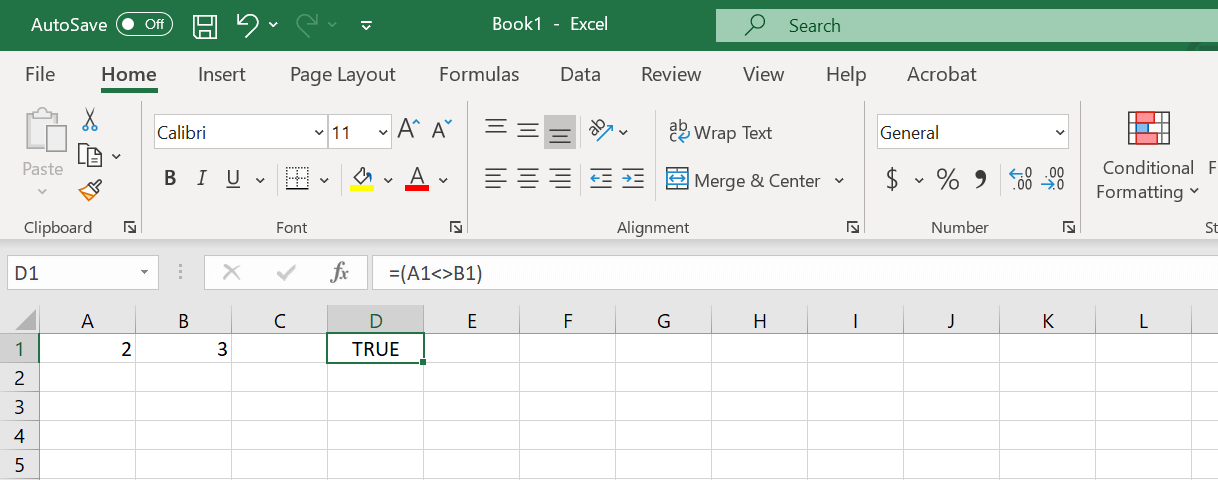
You can also use “does not equal” with more than two cells, columns or values. Simply add another “does not equal” sign and another condition:
=(Condition1<>Condition2<>Condition3)If you want to implement a “not equal to” comparison for several cells or columns, just click on the fill handle (the green square) and pull it down to the rows you want to compare.
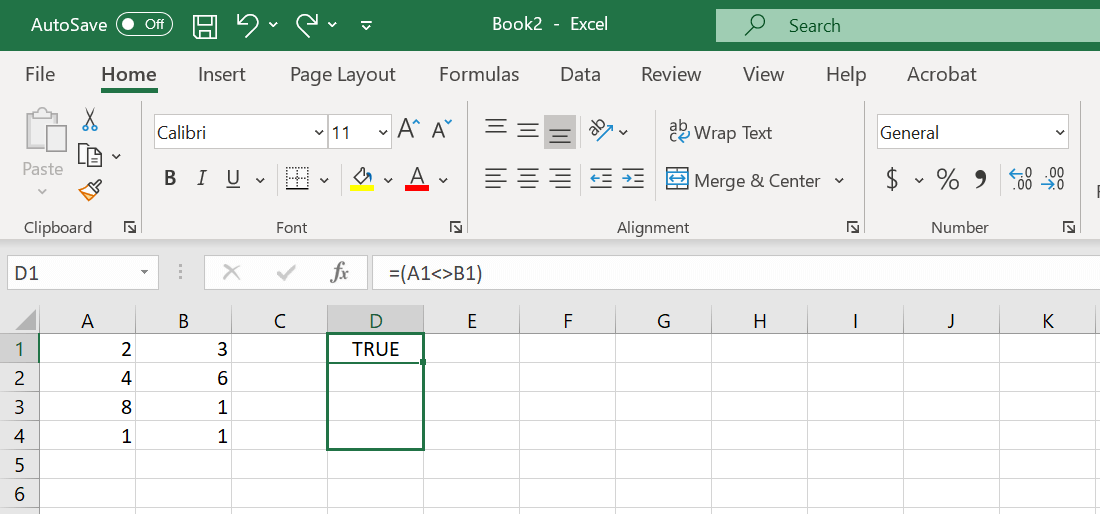
Press Enter to implement the function with absolute reference.
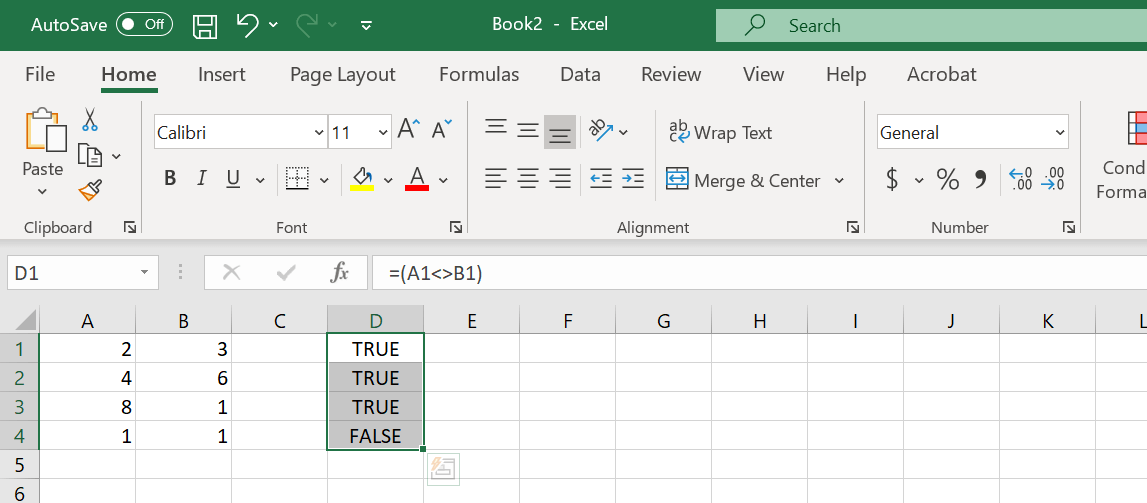
Using the Excel “not equal to” operator in complex functions
Now that we’ve been over the basic use of the “does not equal” operator, let’s take a look at how to effectively embed it in other functions. The values that the Excel “not equal to” operator returns can help in building IF, OR, or NOT functions.
Example 1: “Not equal to” + IF
The “not equal to” sign is particularly useful when combined with the IF function. The IF function asks whether certain conditions are fulfilled and in case that they are, initiates a certain result. When implemented with IF, the “not equal to” sign is very similar to the “equals” sign.
First, let’s take a look at how the “equals” operator is used with IF. Combined with the IF function, it could be used to check who the winner of a raffle is by comparing the winning number to the number each person drew.
According to this function, if the raffle ticket number in cell B3 is equal to the winning number “104”, then the output value will be “Win”. If it is not equal to “104”, the output value will be “Lose”. You can then use the green fill handle to apply the function to as many cells as you need.
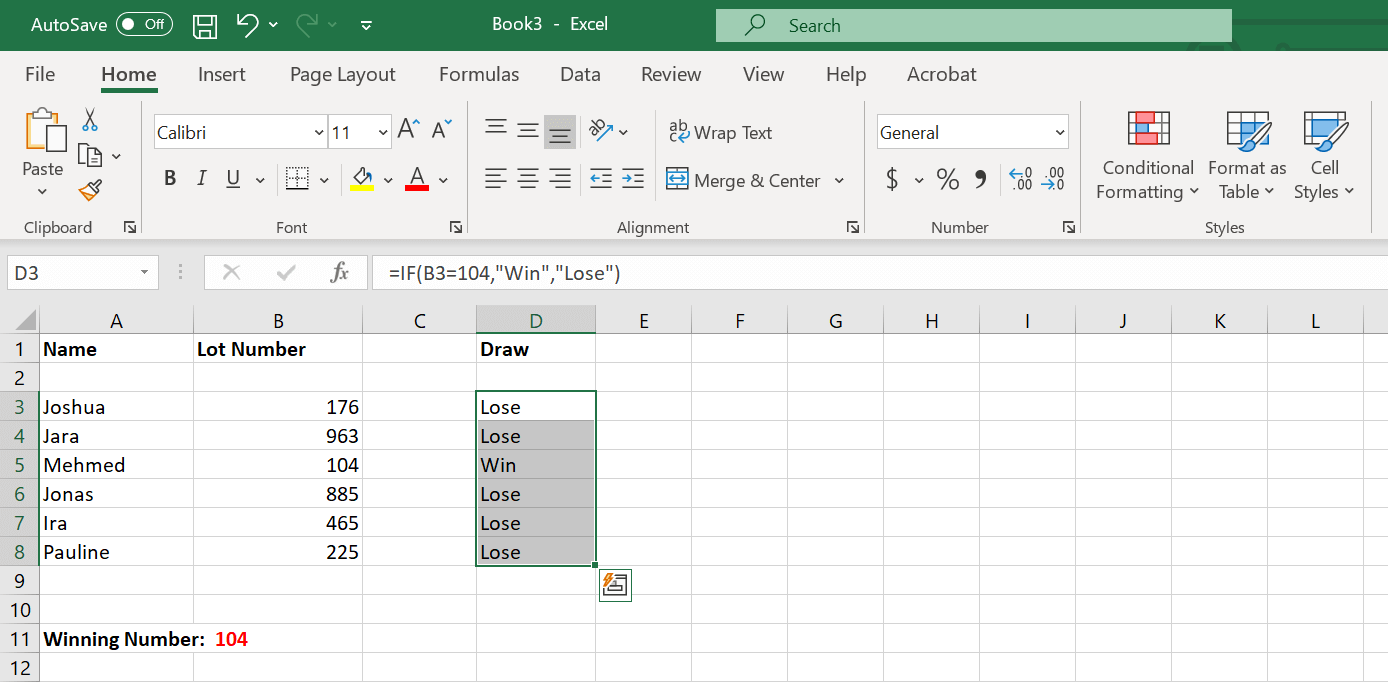
With the “does not equal” operator, the function will be almost exactly the same. Simply replace the EQUALS sign with the “does not equal” sign, and change the positions of “Win” and “Lose”:
=IF(B3<>104, "Lose","Win")This function says that if the raffle ticket number in cell B3 is not equal to the winning number “104”, then the output value will be “Lose”. If it is equal to “104”, the output value will be “Win”.
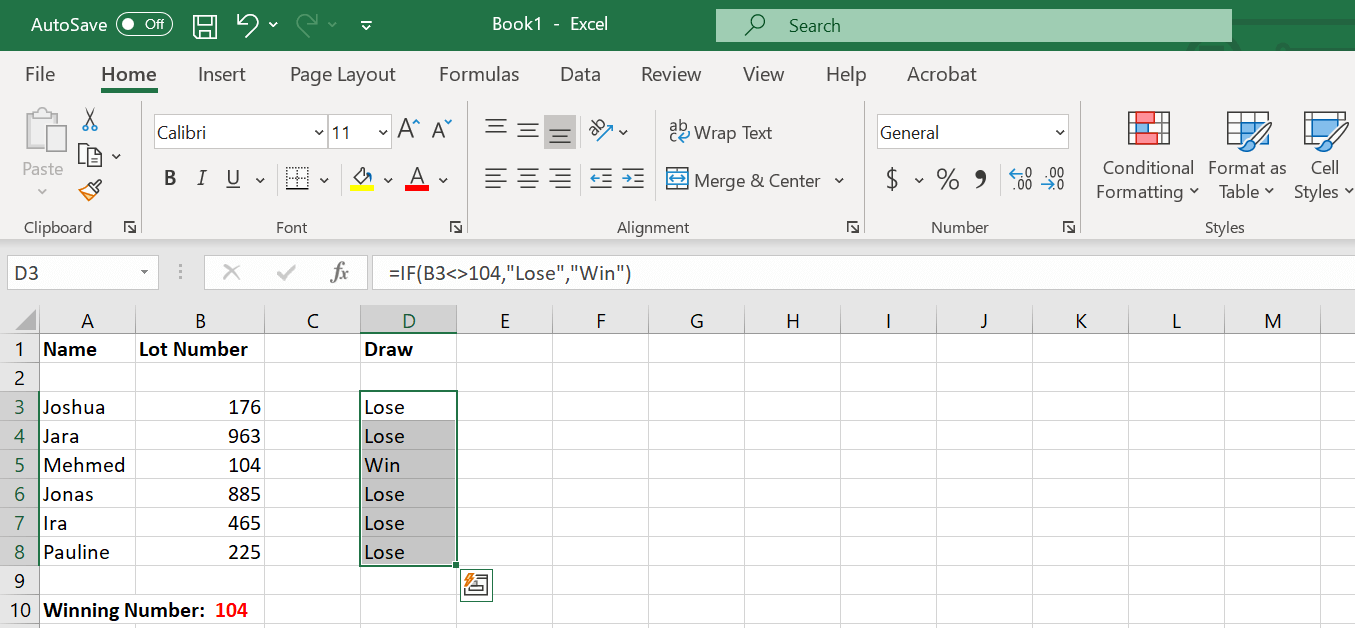
As you can see, you can get similar results with the EQUALS and “not equal to” signs. Thus you can choose whichever operator is better suited to your purposes.
Example 2: “Not equal to” + IF + AND
Once you start combining logical functions and operators, the possibilities are near endless. For example, add the AND function into the mix to make the conditions of the IF function more precise.
Let’s take a look at the syntax for this using the raffle example again.
=IF(AND(A1<>1,B1<>0,C1<>4),"LOSE","WIN")In this case, all three of the listed numbers have to be a match in order to win. If all three of the numbers are not equal to the winning numbers, then the output is “Lose”. Otherwise it’s “Win”.
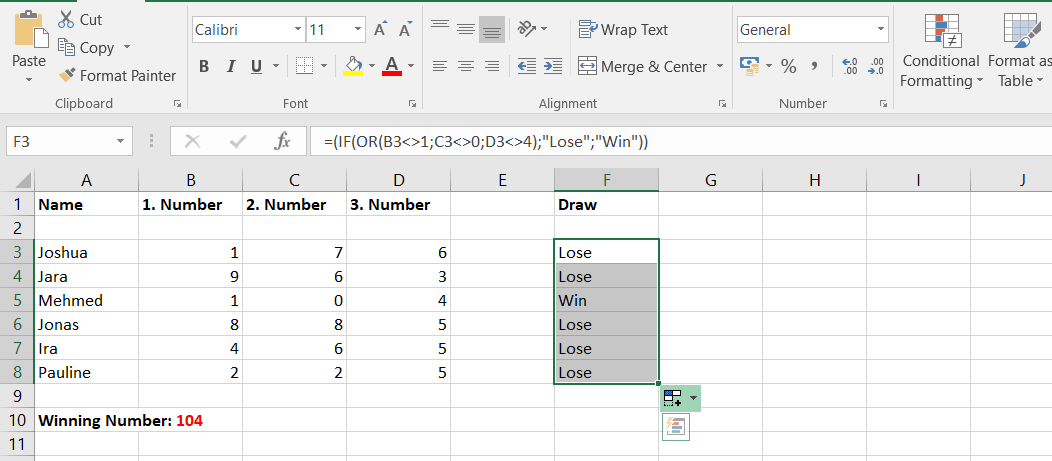
Tip
The OR operator works similarly to AND. Try IF and OR combination for another way to make your functions more precise.
Example 3: „Not equal to“ + „SUMIF“ function
The “not equal to” sign is also useful in combination with the mathematical excel function SUMIF. SUMIF returns the sum of all the numbers that fulfill a certain condition. In the following example, SUMIF is used to add the values from cells whose adjacent cells are not empty (whose value is not equal to empty “”).
=SUMIF(C3:C6,"<>"&"",B3:B6)The function here will look at the values in cells C3-C6 with regard to the criterion “not equal to empty”. The function then adds the values from the cells B3-B6 for the rows that fulfill this criterion (below, rows 3 and 5). The “not equal to” sign must be put in quotations here, and then needs the & sign to combine it with the sign for empty “”.
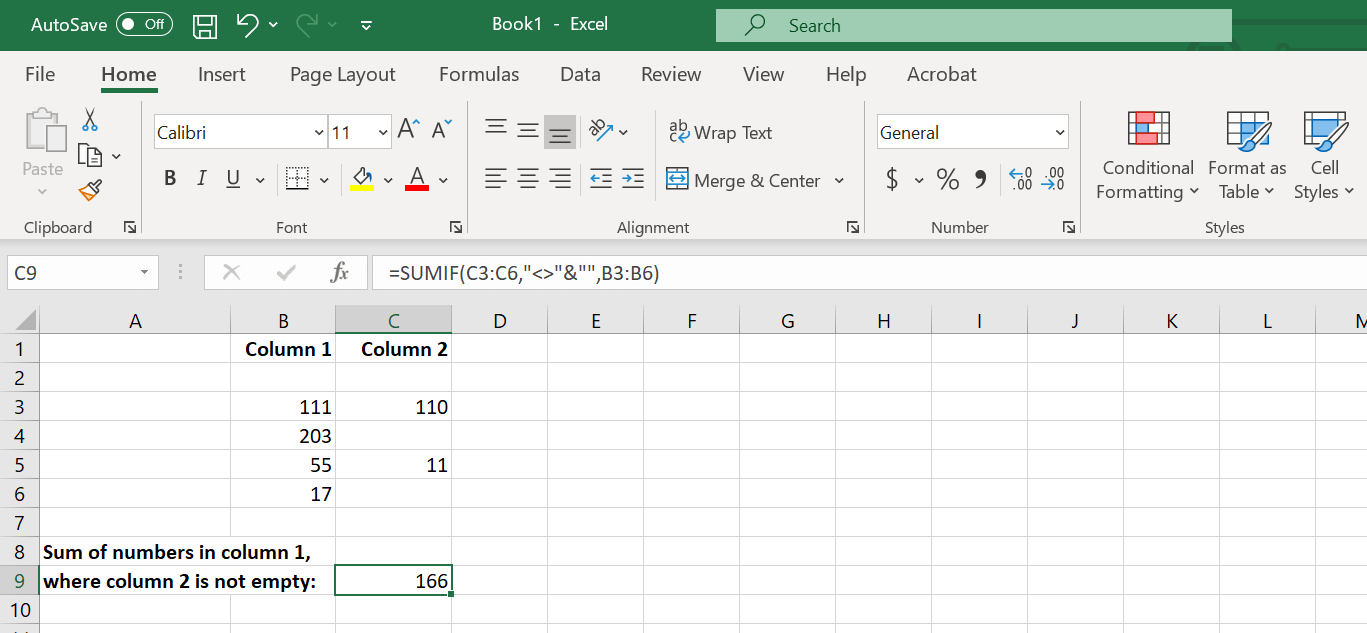
And thus we end up with the sum of the cells in column B whose neighboring cells aren’t empty.
In Excel, <> means not equal to. The <> operator in Excel checks if two values are not equal to each other. Let’s take a look at a few examples.
1. The formula in cell C1 below returns TRUE because the text value in cell A1 is not equal to the text value in cell B1.
2. The formula in cell C1 below returns FALSE because the value in cell A1 is equal to the value in cell B1.
3. The IF function below calculates the progress between a start and end value if the end value is not equal to an empty string (two double quotes with nothing in between), else it displays an empty string (see row 5).
Note: visit our page about the IF function for more information about this Excel function.
4. The COUNTIF function below counts the number of cells in the range A1:A5 that are not equal to «red».
Note: visit our page about the COUNTIF function for more information about this Excel function.
5. The COUNTIF function below produces the exact same result. The & operator joins the ‘not equal to’ operator and the text value in cell C1.
6. The COUNTIFS function below counts the number of cells in the range A1:A5 that are not equal to «red» and not equal to «blue».
Explanation: the COUNTIFS function in Excel counts cells based on two or more criteria. This COUNTIFS function has 2 range/criteria pairs.
7. The AVERAGEIF function below calculates the average of the values in the range A1:A5 that are not equal to 0.
Note: in other words, the AVERAGEIF function above calculates the average excluding zeros.
You can use the NOT function in Excel to change FALSE to TRUE or TRUE to FALSE. To illustrate this function, consider the following example.
8. The OR function below returns TRUE if the value in cell A2 equals «USA» or «UK».
Note: to quickly copy this formula to the other cells, double-click the fill handle (see orange arrow).
9. The formula below returns TRUE if the value in cell A2 is not equal to «USA» or «UK».
Explanation: by adding the NOT function, the logical value returned by the OR function is reversed, so that a TRUE value becomes FALSE, and vice versa.
In Excel, the ‘not equal to’ operator checks if two values are not equal to each other. It can also be combined with conditional functions to automate data calculations.
‘Not equal to’ operator (<>) is one of the six logical operators available in Microsoft Excel, which helps check if one value is not equal to another. It is also known as a Boolean operator because the resulting output of any calculation with this operator can only be either TRUE or FALSE.
The <> is a comparison operator that compares two values. If the values are NOT equal, it will return TRUE, else it will return FALSE. The Not Equal operator is often used along with other conditional functions such as IF, OR, SUMIF, COUNTIF functions to create formulas. Now let’s see how we can use ‘Not Equal to’ in Excel.
How to Use the ‘Not Equal to’ <> Comparison Operator in Excel
The syntax of ‘Not Equal’ is:
=[value_1]<>[value_2]value_1– the first value to be compared.value_2– the second compared value.
Let’s see how the <> operator works in Excel with some formulas and examples.
Example formula:
=A5<>B5As you can see below, the formula in cell C5 returns TRUE because the value in cell A5 is not equal to the value in cell B5.
Here, the formula in cell C6 returns FALSE because the value in cell A6 is equal to the value in cell B6.
Let’s see how the ‘Not Equal to’ operator works with text values. It works the same way as it does with the number value.
Remember ‘Not Equal to’ operator in Excel is ‘case-insensitive’, which means even if the values are in different text cases, case differences will be ignored as shown below.
Using ‘<>’ Operator with Functions
Now that we’ve learned how the ‘not equal’ operator works, let’s see how to effectively combine it in other functions.
Using ‘Not Equal To’ with IF Function in Excel
The <> operator is very useful on its own, but it becomes more useful when combined with an IF function. The IF function checks whether certain conditions are met and in case that they are, it returns a certain result, else it returns another result.
The syntax for the IF function is:
=IF(logical_test,[value_if_true],[value_if_false])Let’s assume we have an inventory list, which lists products and their quantities. If a product’s stock goes below 100, we need to restock it.
Use the below formula:
=IF(C2<>100,"Restock","Full stock")The formula above checks if the quantity of a product (C2) is not equal to 100, if it’s any less than hundred, then it returns ‘Restock’ in cell D2; if quantity is equal to 100, then it returns ‘Full stock’.
Now, drag the fill handle to apply the formula to other cells.
Using ‘Not Equal To’ with COUNTIF Function in Excel
Excel COUNTIF function counts the cells that meet a given condition in a range. If you want to count the number of cells with a value not equal to the specified value, enter COUNTIF with the ‘<>’ operator.
=COUNTIF(range,criteria)The criteria used in COUNTIF are logical conditions that support logical operators (>,<,<>,=).
Let’s say we have a student’s marks list. And we want to count the number of students who have passed the test. Below is the formula used:
=COUNTIF(C2:C9,"<>FAIL")The formula counts cells C2 to C9 if the value is NOT ‘FAIL’. The result is displayed in cell C11.
Using ‘Not Equal To’ with SUMIF Function in Excel
The SUMIF function is used to sum all the numbers when adjacent cells match a certain condition in a range. The general structure of SUMIF function is:
=SUMIF(range,criteria,[sum_range])In the example below, we want to find the total number of fruits ordered that are not mango. We can use the <> operator with SUMIF function to sum all values from the range (B2:B17) whose adjacent cells (A2:A17) are not equal to ‘Mango’. The result is 144 (cell E2).
=SUMIF(A2:A17,"<>Mango",B2:B17)Well, now you learned how to use Not Equal to ‘<>’ in Excel.
What Is “Not Equal To” Sign In Excel?
The Not Equal to in Excel is a feature to compare two numerical values or two Text values. The Sign or Symbol for Not Equal to is “<>”. The Not Equal to in Excel returns “True and False” as the output.
- True denotes that the compared values are different or not equal.
- False denotes that the compared values are the same or equal.
We do not have a pre-defined formula in Excel. However, we can manually write the function as “=value1<>value2”, where Value1 and Value2 are the excel cell references or the numeric and text values.
For example, the image below shows the numerical values in columns A and B. Here, we will compare the numbers in the columns using the Not Equal to in Excel.
Enter the formula =A2<>B2 in cell C2, press the “Enter” key, and drag the formula using the fill handle to cell C3.
The output in the above example is TRUE in cell C2 and FALSE in cell C3, as shown above.
Table of contents
- What Is “Not Equal To” Sign In Excel?
- How Is The “Not Equal To” Sign Used In Excel?
- #1 – Compare Two Numeric Values
- #2 – Compare Two Text Values
- #3 – Use Of IF Function With “Not Equal To” Condition
- #4 – COUNTIF Function With “Not Equal To” Condition
- #5 – SUMIF Function With “Not Equal To” Condition
- Important Things To Note
- Frequently Asked Questions
- Download Template
- Recommended Articles
- How Is The “Not Equal To” Sign Used In Excel?
- The Not Equal to in Excel checks whether the values getting compared, numerical or text, are similar or not.
- The function always requires two values to check. While comparing values, if one of the values is a blank cell, we will get the output as “True”. And if both the cells are blank, we get the output as “False”. These are a few scenarios of the Boolean default values.
- We can use conditional functions such as the IF function, COUNTIF function, and the SUMIF function to get an alternate output instead of the default “True” or “False”.
The Symbol For “Not Equal To” in Excel
The Symbol for Not Equal to in Excel is “<>”. [The less than symbol “<” and the greater than symbol “>” facing each other].
How Is The “Not Equal To” Sign Used In Excel?
We can use the Not Equal to in Excel as follows:
- Compare Two Numeric Values.
- Compare Two Text Values.
- Compare using the IF Function With a “Not Equal To” Condition.
- Compare using the COUNTIF Function With a “Not Equal To” Condition.
- Compare using the SUMIF Function With a “Not Equal To” Condition.
#1 – Compare Two Numeric Values
We will Compare Two Numeric Values using the Not Equal to in Excel.
In the following table, the data is,
- Column A contains Value1.
- Column B contains Value2.
- Column C is for the Output.
The steps to Compare Two Numeric Values are as follows:
Step 1: Select cell C2 and enter the formula =A2<>B2.
Step 2: Press the “Enter” key. The result is “True”.
Step 3: Drag the formula from cell C2 to cell C5. The output is shown in the image below.
#2 – Compare Two Text Values
We will Compare Two Text Values using the Not Equal to in Excel.
In the following table, the data is,
- Column A contains Text1.
- Column B contains Text2.
- Column C is for the Output.
The steps to Compare Two Text Values are as follows:
Step 1: Select cell C2 and enter the formula =A2<>B2.
Step 2: Press the “Enter” key. The result is “True”.
Step 3: Drag the formula from cell C2 to cell C5. The output is shown in the image below.
#3 – Use Of IF Function With “Not Equal To” Condition
We will compare values using the IF excel function With “Not Equal To” Condition. The IF function permits us to get any desired output in place of the default “True or False”.
In the following table, the data is,
- Column A contains the Fruits.
- Column B contains the Status.
- Column C for the output.
The steps to compare cells using the IF function are as follows:
Step 1: Select cell C2 and enter the formula =IF(B2<>“Order,” “Sale,” “Out of stock”).
Step 2: Press the “Enter” key. The result is “Out of Stock” w.r.t the IF function condition.
Step 3: Now, drag the formula from cell C2 to cell C5. The output is shown in the image below.
#4 – COUNTIF Function With “Not Equal To” Condition
The COUNTIF function is from the COUNT function family in Excel, like the COUNTA and COUNTBLANK functions. It is a pre-defined function in Excel that counts all the cells in the range as specified by the conditions.
The formula of the COUNTIF function is,
=COUNTIF(range,criteria)
We will compare values using the COUNTIF Function With “Not Equal To” Condition.
In the following table, the Pokémon data is,
- Column A shows the Name.
- Column B contains the Type.
- Column C contains the Total Status.
- Columns E and F are for the COUNTIF
The steps to compare cells using the COUNTIF function are as follows:
Step 1: Select cell F2 and enter the formula =COUNTIF(B2:B7,“<>Fighter”).
Step 2: Press the “Enter” key. The result is ‘4’ w.r.t the COUNTIF function condition.
Therefore, the output is 4, which denotes that there are 4 Pokémon that are not the “Fighter” type.
#5 – SUMIF Function With “Not Equal To” Condition
The SUMIF excel function is from the SUM function family in Excel, like the SUM and SUMPRODUCT functions. It is a pre-defined function in Excel that adds all the cells in the range as specified by the conditions.
The formula of the SUMIF function is,
=SUMIF(range,criteria,[sum_range])
We will compare values using the SUMIF Function With “Not Equal To” Condition.
In the following table, the data is,
- Column A shows the City.
- Column B contains the Category.
- Column C contains the Sates.
- Columns E, F, and G are for the Output.
The steps to compare cells using the SUMIF function are as follows:
Step 1: Select cell G2 and enter the formula =SUMIF(C2:C7,“<>Snacks”).
Step 2: Press the “Enter” key. The result is ‘$1,18,10,894’ w.r.t the SUMIF function condition.
Important Things To Note
- The sign or Symbol for Not Equal to is ≠, however, in Excel, we use “<>” symbol. [The less than symbol “<” and the greater than symbol “>” facing each other].
- The Not Equal to in Excel is case-insensitive. So, whether the strings compared are uppercase, lowercase, or a combination of both, the function will return accurate results.
- We can also compare a numeric value with a text value, as shown below. Again, the output will be “True”, implying that the two values are different.
Frequently Asked Questions
How do you write Not Equal To in Excel?
We write the Not Equal to in Excel as =value1<>value2 as we do not have an inbuilt function in Excel. [Value1 and Value2 are the cell references with numerical or text values].
What does “<>” mean in Excel?
The “<>” is the Not Equal to in Excel operator or symbol that detects whether the values match or not. If the values are the same, the output is “TRUE”, and if the values are different, the output is “False”.
How to write Not Equal To blank cells in Excel?
We will use the Not Equal to in Excel to compare with the blank cells.
In the following table, the data is,
1. Column A shows the Value.
2. Column B for the Output.
The steps to compare cells using Not Equal to in Excel are as follows:
Step 1: Select cell B2 and enter the formula =A2<>“”.
Step 2: Press the “Enter” key. The result is ‘True’.
Step 3: Drag the formula from cell B2 to cell B5. The output is shown in the image below.
Download Template
This article must help understand Not Equal To in Excel with its formula and examples. You can download the template here to use it instantly.
Recommended Articles
This has been a guide to Not Equal To in Excel. Here we use the symbol, formulas along with examples and a downloadable excel template. You can learn more from the following articles –
- Change Case In Excel
- Date Format In Excel
- Autofill In Excel
Last Update: Jan 03, 2023
This is a question our experts keep getting from time to time. Now, we have got the complete detailed explanation and answer for everyone, who is interested!
Asked by: Brook Cormier
Score: 4.5/5
(15 votes)
Excel’s «does not equal» operator is simple: a pair of brackets pointing away from each other, like so: «<>«. Whenever Excel sees this symbol in your formulas, it will assess whether the two statements on opposite sides of these brackets are equal to one another.
What does colon mean in Excel?
The colon tells Excel to include all cells between the two endpoint cell references. If I just wanted to input the B column into a function, the reference would be B1:B7.
How do I use the symbol function in Excel?
$ Symbol in excel is used to lock a specific cell or rows or columns in a worksheet, the shortcut to lock down a reference in excel is by pressing ALT + F4, this feature is used while working in formulas when we do not want the reference to be changed when we copy or drag down the formula to other cell references, this …
What does not mean in Excel?
What is the NOT Function? The NOT function is an Excel Logical function. The function helps check if one value is not equal to another. If we give TRUE, it will return FALSE and when given FALSE, it will return TRUE. So, basically, it will always return a reverse logical value.
Is equal in Excel?
Using «Equal to» logical operator in Excel. Returns TRUE if the values in cells A1 and B1 are the same, FALSE otherwise. Returns TRUE if cells A1 contain the word «oranges», FALSE otherwise. Returns TRUE if cells A1 contain the Boolean value TRUE, otherwise it returns FALSE.
37 related questions found
How do you write not equal to blank in Excel?
The <> symbol is a logical operator that means «not equal to», so the expression <>»» means «not nothing» or «not empty». When column D contains a value, the result is TRUE and IF returns «Done». When column D is empty, the result is FALSE and IF returns an empty string («»).
What does not function mean?
The NOT function reverses the value of its argument. One common use for the NOT function is to expand the usefulness of other functions that perform logical tests. … Logical Required. A value or expression that can be evaluated to TRUE or FALSE.
How do you find equal text in Excel?
Compare two strings
- =A1=A2 // returns TRUE.
- =EXACT(A1,A2) // returns FALSE.
- =IF(EXACT(A2,A2),»Yes»,»No»)
How do I make text equal a value in Excel?
Convert Text to Numbers Using ‘Convert to Number’ Option
- Select all the cells that you want to convert from text to numbers.
- Click on the yellow diamond shape icon that appears at the top right. From the menu that appears, select ‘Convert to Number’ option.
Which is not function in Excel?
The Microsoft Excel NOT function returns the reversed logical value. The NOT function is a built-in function in Excel that is categorized as a Logical Function. It can be used as a worksheet function (WS) in Excel.
How do you use does not equal in Excel Sumifs?
The SUMIF function supports all of the standard Excel operators, including not-equal-to, which is input as <>. When you use an operator in the criteria for a function like SUMIF, you need to enclose it in double quotes («»).
Why does Excel say cell values are not equal when they are?
Spaces Before or After Your Values
These ‘ghost’ characters take form as spaces and if they occur in the beginning or end of text, we cannot see any visual evidence of their existence! In the example below, Cell C2 is testing to see if A2 = B2. This text is giving us a FALSE which means they do not equal each other.
How do I remove spaces from Excel?
Remove all spaces between numbers
- Press Ctrl + Space to select all cells in a column.
- Press Ctrl + H to open the «Find & Replace» dialog box.
- Press Space bar in the Find What field and make sure the «Replace with» field is empty.
- Click on the «Replace all» button, and then press Ok. Voila! All spaces are removed.
What is an Xlookup in Excel?
The XLOOKUP function searches a range or an array, and then returns the item corresponding to the first match it finds. If no match exists, then XLOOKUP can return the closest (approximate) match.
What is IF AND THEN statement?
A conditional statement (also called an if-then statement) is a statement with a hypothesis followed by a conclusion. The hypothesis is the first, or “if,” part of a conditional statement. The conclusion is the second, or “then,” part of a conditional statement. The conclusion is the result of a hypothesis.
Can you use if and/or together in Excel?
When you combine each one of them with an IF statement, they read like this:
- AND – =IF(AND(Something is True, Something else is True), Value if True, Value if False)
- OR – =IF(OR(Something is True, Something else is True), Value if True, Value if False)
- NOT – =IF(NOT(Something is True), Value if True, Value if False)
Can you have 3 conditions in an if statement?
Yes, it is. Since all three conditions are met, the IF statement is TRUE and returns the word Pass in cell H53.
How is a function not a function?
A function is a relation between domain and range such that each value in the domain corresponds to only one value in the range. Relations that are not functions violate this definition. They feature at least one value in the domain that corresponds to two or more values in the range.
Which is not a primary function of Excel?
word processor is not a primary function of excel.
What makes a set not a function?
A relation from a set X to a set Y is called a function if each element of X is related to exactly one element in Y. That is, given an element x in X, there is only one element in Y that x is related to. … It’s still a function, it’s just not a one-to-one function.

